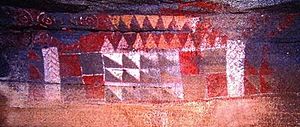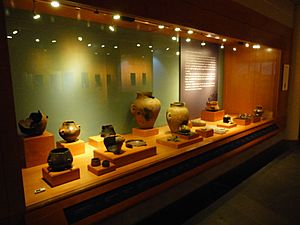Painted Cave, Galdar facts for kids
Quick facts for kids Painted cave, Las Palmas |
|
|---|---|
| Native name Spanish: Cueva Pintada |
|

Painted cave in Galdar, Grand Canary island
|
|
| Location | 2, Audiencia street, Galdar, Grand Canary, Canary islands, Spain |
| Area | ~5,000 m2 |
| Visitors | 54,190 (in 2015) |
| Website | Painted cave museum and archaeological park |
| Official name: Cueva Pintada | |
| Type | Cultural |
| Designated | 25 May 1972: Historic Artistic monument; 19 November 1990: Property of Cultural Interest |
| Reference no. | RI-55-0000273 |
| Lua error in Module:Location_map at line 420: attempt to index field 'wikibase' (a nil value). | |
The Painted Cave (or Cueva Pintada in Spanish) is an amazing archaeological museum and park. It is located in the town of Galdar, on the northwest side of Grand Canary island in Spain. This special place is looked after by the Spanish Ministry of Culture.
Inside, you can find some of the most important ancient artworks from the Canary Islands. These artworks were made by the first people who lived there, called the Canarii. The Painted Cave is so important that some people call it the "Sistine Chapel" of the island's ancient inhabitants.
Contents
Where is the Painted Cave?
The Painted Cave is at 2 Audiencia street, right in the middle of Gáldar. It's about 27 kilometers (17 miles) west of Las Palmas. It is also about 50 kilometers (31 miles) northwest of the Gran Canaria international airport.
How the Painted Cave Was Found
The cave was first found by accident in 1862. Farmers were working and discovered a hole in its roof. The "official" discovery happened in 1873 when José Ramos Orihuela visited the cave.
In the late 1800s, many people became interested in the cave. Researchers like Gregorio Chil y Naranjo and René Verneau wrote about it. Olivia Stone even made drawings and suggested the government should protect the site.
Protecting the Paintings
Over time, the beautiful paintings inside the cave started to get damaged. This was mainly because of humidity and water from nearby farms. People began to worry and asked for the cave to be protected.
In 1970, work started to save the cave. They built a special cover to protect it from the weather. In 1972, the site was officially named a Historic Artistic Monument.
More studies showed that the paintings were still in danger. Water from farms, chemicals in the soil, and poor air circulation were causing problems. Because of this, the cave was closed to visitors in 1982.
Reopening the Museum
After 24 years of careful work, the Painted Cave Museum and Archaeological Park reopened on July 26, 2006. During this time, experts dug up more of the site and restored the paintings. Now, visitors can see the real cave without harming it.
You can visit the museum from 10 a.m. to 6 p.m. All visits include a guide, and you need to book your visit ahead of time. Guides are available in four languages.
In 2016, the museum celebrated its 10th anniversary. It even exchanged valuable ancient items with the famous cave of Altamira museum in Spain.
What You Can See
The Painted Cave Itself
The cave shows amazing art from the ancient people of Gran Canaria. The cave and the old village next to it are in Galdar, which used to be the island's capital.
The cave was dug out of volcanic rock by humans. Its walls are covered with cool geometric patterns. Scientists think these patterns might have been a kind of calendar. This is because they often appear in groups of twelve.
Gran Canaria is the only Canary Island where painted caves have been found. It's also the only place on the island where proof of ancient common wheat has been found.
Ancient Tools and Items
The site also has remains of old houses. Inside these houses, many different tools and items were found. The collection includes beautiful handmade ceramic pots from the island. Some pots are very large and were used for storing food. Others were used for cooking.
Many of the local pots have smooth surfaces and are decorated with red paint. This paint was put on before the pots were baked in the ground. Some pots are completely covered in geometric designs, even on the bottom! Gran Canaria is the only Canary Island where painted pottery has been discovered.
You can also see small clay statues of human and animal figures. Many of the human statues are female and seem to be connected to motherhood. Some statues have red paint and carved hair. These might have been offerings, good luck charms, or even toys.
Other items found include needles, stamps, and spatulas made from animal bones. The needles were used for making leather clothes. The stamps and spatulas were tools for making pottery.
Stone tools were also found. People used basalt, phonolite, and obsidian stones. They shaped these stones to make sharp edges for cutting meat or working with wood, bone, and animal skins. Basalt was also used to make grinding stones called mortars. Some round mortars were used to grind grain into flour. Others were used to grind the red ochre for painting the cave walls and decorating pots.
The Ancient Village
Over twenty years of digging have revealed a whole village around the Painted Cave. This village was part of ancient Agaldar. People lived here from the 6th to the 11th century, and again from the 13th to the 16th century. This was just before the Spanish took over the island.
The houses were square-shaped and had round walls outside. They often had one or two bedrooms that opened to the south. The builders used the natural rock to support the walls and made flat floors inside the houses. These floors were covered with packed earth or sometimes with stones, which were sometimes colored with red ochre.
The walls were built using basalt stones or well-cut blocks of tuff. Many houses still have bits of mortar and paint on their walls, showing how colorful they once were.
This ancient village helps us understand what life was like in the Canary Islands just before the Spanish arrived.
How Old is the Site?
Scientists used a method called carbon-14 dating to find out how old the site is. They tested plant remains found in the mortar of the walls. These remains were dated to between 1049 and 1257 AD. Some pieces of pine tree were even older, dating from 601 to 994 AD.
What the Museum Does
The Painted Cave Museum and Archaeological Park has several important goals:
- To protect, organize, and display the ancient items they find.
- To create educational programs for schools and visitors.
- To do research, especially on how to keep the painted cave safe.
Special Facilities
The museum has special areas to help with its goals:
- The didactic classroom hosts activities for students and anyone who wants to learn more about the island's ancient people.
- The laboratories and library help researchers and restorers study and protect the artifacts. This makes the Painted Cave a key place for scientific knowledge.
- A multi-purpose room is also available for different events.
A Popular Place to Visit
The Painted Cave is a very popular place! In its first five months after reopening in 2006, it had over 34,000 visitors. By December 2015, over half a million people had visited. It gets around 50,000 visitors each month.
This makes it one of the most visited archaeological sites in Spain and Europe. Visitors love it, giving it a very high rating of 9.15 out of 10!
See also
 In Spanish: Museo y Parque Arqueológico Cueva Pintada para niños
In Spanish: Museo y Parque Arqueológico Cueva Pintada para niños





